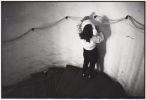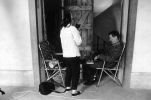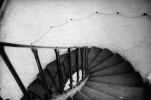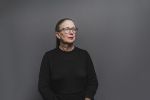"Thirty small speakers circle the stair walls, leading up to the upper floor. I remembered only that these stairs led to rooms of the nuns who lived here before – unless I invented this, retrospectively, to make this piece fit more neatly. As one mounts the stairs, remembering or not these absent women who may or may not have existed, a sound, a whisper precedes or follows one´s step, tracing the way.
It is difficult to decipher, this murmur of women’s voices, punctuated by a breath, a sharp and painful intake of air to force the next well–learnt word from the body. It is an English text that may as will be Latin or Czech or Italian. A Catholic upbringing, if one remembers, will recall the words... Holy Mary... Holy Mother... Holy Mother of God... and all the names of the Blessed Virgin – 52 to be exact – which made up this litany and mark the ascent and descent of the flight of stairs.
Remembered, imagined breath and the light whispers of real and fictitious women which circle, connect and endlessly repeat the echoing path of faith and duty, of devotion to prayer."
Sharon Kivland, 1993
Sharon Kivland (born 1955, USA) lives and works in London and Pleslin, France. Apart from her activities as an artist and curator, she also engages in theoretical investigations, both teaching art at Sheffield Hallam University and as a Research Associate at the Centre for Freudian Analysis and Research in London. Since 1979, she has taken part in numerous solo and group shows in Europe and North America.
The main medium in Sharon Kivland's work is color photography. Further major areas of activity are objects of metal, leather, cloth, glass, mirrors and so on. The two approaches may be combined; and in both, written text is often a complementary element.
In her work, Sharon Kivland investigates how our lives are governed by systems of order that complement, overlap and contradict one another while undergoing periods of change continually. Spheres such as language, gender, time/space, art, philosophy, politics, nature, history, and economy are involved. The focus of this approach is represented by the identity of woman and her body.






